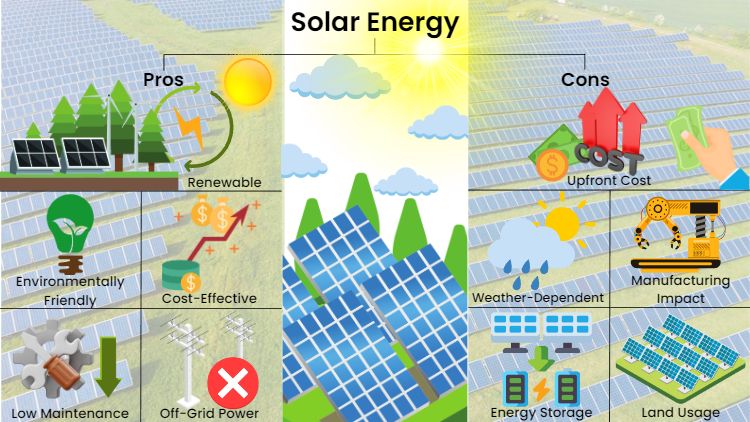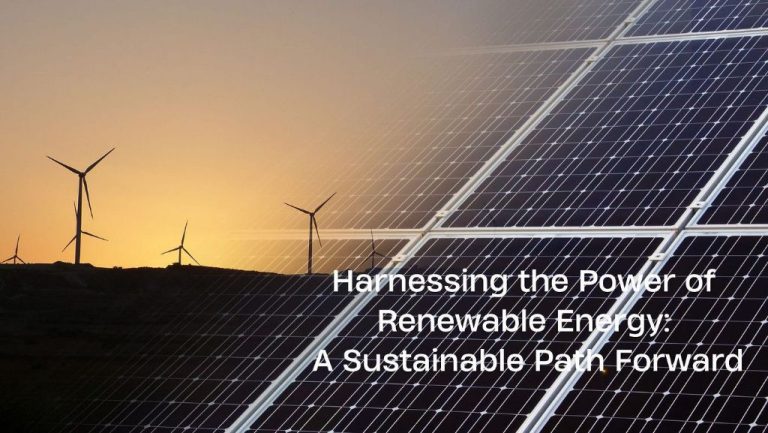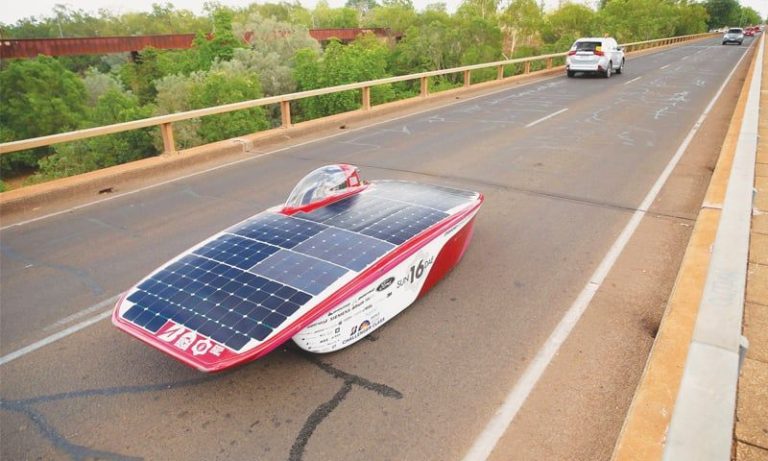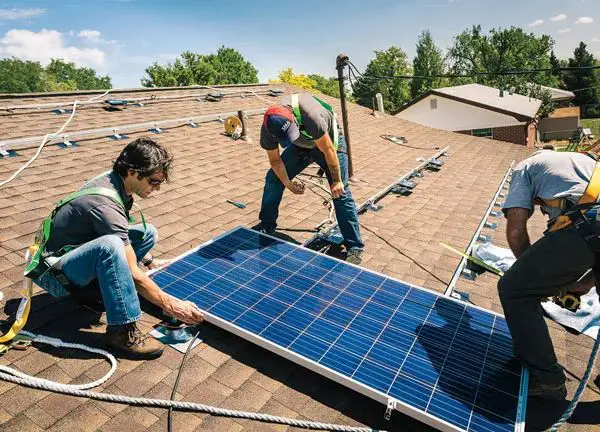On What Principle Does A Solar Cell Works?
Introduction
A solar cell (also called a photovoltaic cell) is a device that directly converts sunlight into electricity using the photovoltaic effect. The photovoltaic effect refers to electrons being emitted from a material when exposed to electromagnetic radiation, like sunlight.
Solar cells have a long history beginning in 1839 when the photovoltaic effect was first observed by French physicist Edmund Becquerel. The first solar cell capable of converting enough sunlight into power to run electrical equipment was invented in 1883 by Charles Fritts, who coated selenium with an extremely thin layer of gold to form the junctions. However, the semiconductor materials used in solar cells today were not developed until the 1950s.
Today, solar cells have many applications and are used in a wide variety of technologies. The most common application is converting sunlight into electricity in photovoltaic solar panels. Solar panels on rooftops, solar farms, and orbiting satellites all rely on solar cells. Solar cells are also used in solar-powered calculators, watches, traffic lights, homes, and more. With concerns over climate change and fossil fuel depletion, solar power is becoming an increasingly important renewable energy source.
How Solar Cells Work
Solar cells work through the photovoltaic effect, which describes the process of a semiconductor material generating electricity when exposed to sunlight. The photovoltaic effect was first observed in 1839 by French physicist Edmond Becquerel.
Semiconductors like silicon are used in solar cells because of their unique electrical properties. Pure silicon is not a good conductor of electricity, but when impurities are intentionally added through a process called doping, silicon takes on desired conductive properties.
Solar cells are made up of two types of semiconductors, called p-type and n-type silicon. The p-type silicon has an excess of positive charge carriers called holes, while the n-type silicon has an excess of negative charge carriers called electrons. When these two materials are placed together, a p-n junction is formed.
The p-n junction is where the magic of solar power happens. When sunlight hits the solar cell, the photons are absorbed by the semiconductors, knocking electrons loose and causing them to flow freely. The p-n junction provides an electric field that forces the electrons to flow in one direction, creating an electrical current that can be captured and utilized. This is the basic principle allowing solar cells to convert sunlight into electricity.
![]()
Solar Cell Structure
A solar cell is made of several components that enable it to absorb sunlight and convert it into electricity. Here are the main parts of a basic solar cell:
Front Contacts
The front contacts are located on the front surface of the solar cell. They are thin wires or metallic strips that collect electrons from the semiconductor layer. The front contacts are made of materials like silver, aluminum or copper.
Semiconductor Layer
This is the core of the solar cell. It is made of a semiconductor material like silicon that can generate electrons when exposed to photons from sunlight. The semiconductor has two layers – a negative layer with extra electrons, and a positive layer lacking electrons.
Back Contacts
The back contacts form a conductive layer on the back of the cell. They allow electrons to flow from the semiconductor out to the external circuit. Back contacts are made of materials like aluminum and silver.
Generating Electricity
Solar cells generate electricity through the photovoltaic effect. When photons from sunlight hit the solar cell, they transfer their energy to the semiconductor material in the cell. This energizes the electrons in the material and causes them to break free from their atoms. These free electrons are able to flow through the material and generate an electric current.
The front surface of the solar cell has an electric field that acts to force electrons freed by the photons to flow in a certain direction. Metal conductors on the solar cell collect the electrons and transfer them to wires, producing electric current. In essence, the photons knock electrons loose, allowing them to flow and generate electricity.
Solar cells have a positive and negative layer that forms an electric field. When light energy strikes the cell, electrons are knocked loose from the atoms of the semiconductor material. The electric field propels these electrons in a particular direction, creating a flow of electricity. This electricity generation works as long as light shines on the solar panels.
Solar Cell Efficiency
The efficiency of a solar cell refers to what percentage of the sun’s energy striking the cell is converted into usable electricity. There are several factors that affect a solar cell’s efficiency.
The most important factor is the semiconductor material used in the cell. Silicon is the most common, but materials like gallium arsenide and perovskites can achieve higher efficiency levels. However, they tend to be more expensive or difficult to produce than silicon.
Other factors like cell temperature and light intensity also impact efficiency. Solar cells become less efficient as they heat up. And low light conditions, like on a cloudy day, reduce efficiency.
Over the decades, researchers have steadily improved solar cell efficiency through better materials and designs. The current record for a traditional silicon cell is around 27%. But experimental multi-junction cells using more exotic semiconductors have reached efficiencies over 40%.
Ongoing research aims to make solar cells even more efficient. Approaches include using nanotechnology to better capture light, stacking multiple thin junctions together, and integrating concentrating lenses or mirrors to focus more sunlight onto the cell.
Higher efficiency means that solar panels can produce more electricity from the same footprint. So improving efficiency is key to reducing solar power costs and making it more competitive with fossil fuels.
Manufacturing Solar Cells
The manufacturing process for solar cells involves gathering the necessary raw materials, purifying them, and assembling the solar cell components. The key raw materials needed are silicon, phosphorus, boron, and thin conductive wires.
Silicon is one of the most abundant elements on Earth and is a common semiconductor material used in solar cells. High purity silicon is needed, so the raw silicon undergoes a purification process to remove impurities. This involves converting sand or quartzite to metallurgical grade silicon, then converting that to trichlorosilane or silane gas, and then depositing the gas onto a silicon seed rod to produce polysilicon with very high purity levels.
Phosphorus and boron are used to dope the silicon to give it the necessary semi-conductive properties. Thin wires provide the conductive pathways to capture the electrical current produced by the solar cell. Once the purified silicon wafer, phosphorus, boron, and wiring are ready, the solar cell can be assembled piece by piece using deposition, doping, etching, and connection techniques to build up the layers and circuitry of the cell.
Installing Solar Panels
Installing solar panels on your home or business requires careful planning and execution. Here are some key considerations when it comes to mounting, orienting, tilting, and connecting solar panels:
Mounting Systems
Solar panels can be mounted on your roof, on the ground, or on other structures. Roof mounts usually minimize space usage and avoid shading, but may require roof penetrations. Ground mounts allow you to orient panels optimally, but require adequate sunny space. Pole mounts get panels above shading objects. The mounting system must be engineered to withstand wind, snow, seismic activity per local building codes.
Orientation and Tilt
For maximum production, solar panels should face true south in the northern hemisphere, or true north in the southern hemisphere. However, east-west facing panels can also work well. Panels are typically tilted at an angle equal to the latitude of the location, but adjustments may optimize seasonal or time-of-day production. Careful orientation and tilt ensure solar panels capture the most sunlight throughout the year.
Electrical Connections
Cabling connects solar panels together in series to produce the desired voltage output. This output ties into a solar inverter which converts DC from the panels into AC used by the building. Proper wiring sizes, connectors, and grounding are needed to handle the solar array output. Electrical connections should be made per local electrical codes for safety and optimal performance.
Advantages of Solar Power
Solar power provides several key advantages that make it an appealing energy source for homeowners, businesses and utilities:
Renewable
Solar energy is a renewable energy source. Unlike fossil fuels which are finite and may eventually run out, the sun’s energy is unlimited and available every day. Solar panels can keep producing clean electricity for decades once installed.
Reduces Electricity Bills
Putting solar panels on your roof provides free electricity during the daytime. This allows you to reduce your energy bills by relying less on electricity from the grid. Any excess solar electricity produced can even be sold back to the grid.
Low Maintenance
Solar panels are very reliable and require little maintenance over their lifespan of 20-30 years. Apart from occasionally washing off dirt and dust, solar panels are mainly self-sufficient. This makes solar power a very low maintenance way of meeting your energy needs.
Disadvantages of Solar Power
While solar power offers many benefits, it also has some drawbacks that need to be considered:
Intermittent Source: The amount of electricity generated by solar panels fluctuates based on the amount of sunlight available. Solar output varies throughout the day and seasons, with less production on cloudy days or at night. This intermittency can cause issues for electrical grid stability and management.
High Upfront Costs: The initial investment for purchasing and installing a solar system is quite high compared to other electricity sources. Though solar pays for itself over time, the steep upfront cost can deter some homeowners and businesses from adopting solar.
Land Use Conflicts: Large solar farms require significant land area which could otherwise be used for agriculture, conservation, or development. This can create zoning and land use conflicts, especially in densely populated areas.
Future of Solar Power
The future looks bright for solar power as researchers work to improve efficiency and lower costs. Some key trends in solar technology include:
Improving Efficiency and Costs
Companies are developing new solar cell designs, manufacturing techniques, and materials to improve efficiency and lower costs. For example, perovskite solar cells have increased in efficiency from 3% to over 20% in just a few years. Continued advances could make solar power cost competitive with fossil fuels.
New Technologies
Emerging technologies like solar paints, solar windows, and solar roads could enable new applications for capturing solar energy. These innovations could allow solar cells to be integrated into building materials and infrastructure.
Projected Growth
Solar power capacity is projected to grow exponentially in the coming decades. The International Energy Agency predicts solar PV installations could reach up to 5,700 gigawatts worldwide by 2040, more than 10 times current capacity. Government incentives and lowering costs will continue to drive adoption of solar power globally.





